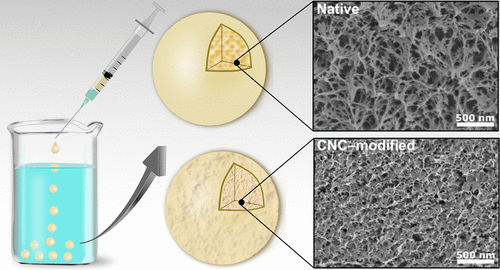当前位置:
X-MOL 学术
›
Ind. Eng. Chem. Res.
›
论文详情
Our official English website, www.x-mol.net, welcomes your
feedback! (Note: you will need to create a separate account there.)
In Situ Modification of Regenerated Cellulose Beads: Creating All-Cellulose Composites
Industrial & Engineering Chemistry Research ( IF 3.8 ) Pub Date : 2020-01-30 , DOI: 10.1021/acs.iecr.9b06273 Katarzyna Mystek 1 , Michael S. Reid 1 , Per A. Larsson 1 , Lars Wågberg 1, 2
Industrial & Engineering Chemistry Research ( IF 3.8 ) Pub Date : 2020-01-30 , DOI: 10.1021/acs.iecr.9b06273 Katarzyna Mystek 1 , Michael S. Reid 1 , Per A. Larsson 1 , Lars Wågberg 1, 2
Affiliation

|
Developing more sustainable products requires innovative ways to utilize and modify renewable resources. Here, a simple one-step in situ modification of regenerated cellulose beads using cellulose nanocrystals (CNC) and dropwise precipitation of cellulose/N,N-dimethylacetamide and lithium chloride (DMAc/LiCl) solution is presented. A more condensed internal structure and increased surface roughness were observed when higher CNC concentrations were used in the precipitation media. Incorporation of CNCs significantly reduces the water holding capacity of the beads and simultaneously impacts the kinetics of drying. Beads modified using the highest CNC concentration (0.5 wt %) exhibited a reduction in the Young modulus by more than 20% and an increase in compressibility to failure by 10% compared with native beads. Overall, inclusion of nanoparticles during bead formation is a simple method that can tune the mechanical, structural, and swelling/drying behavior of cellulose beads and broaden their potential for different end-use applications such as separations and controlled release.
中文翻译:

再生纤维素微珠的原位修饰:创建全纤维素复合材料
开发更具可持续性的产品需要创新的方式来利用和修改可再生资源。在这里,提出了使用纤维素纳米晶体(CNC)对纤维素微粒,N / N,N-二甲基乙酰胺和氯化锂(DMAc / LiCl)溶液进行逐滴沉淀的简单的一步式再生纤维素珠原位修饰方法。当在沉淀介质中使用较高的CNC浓度时,观察到内部结构更加凝结,表面粗糙度增加。加入CNC控制器会大大降低珠粒的持水量,同时会影响干燥的动力学。与天然微珠相比,使用最高CNC浓度(0.5 wt%)改性的微珠,其杨氏模量降低了20%以上,断裂压缩性提高了10%。总体,
更新日期:2020-01-31
中文翻译:

再生纤维素微珠的原位修饰:创建全纤维素复合材料
开发更具可持续性的产品需要创新的方式来利用和修改可再生资源。在这里,提出了使用纤维素纳米晶体(CNC)对纤维素微粒,N / N,N-二甲基乙酰胺和氯化锂(DMAc / LiCl)溶液进行逐滴沉淀的简单的一步式再生纤维素珠原位修饰方法。当在沉淀介质中使用较高的CNC浓度时,观察到内部结构更加凝结,表面粗糙度增加。加入CNC控制器会大大降低珠粒的持水量,同时会影响干燥的动力学。与天然微珠相比,使用最高CNC浓度(0.5 wt%)改性的微珠,其杨氏模量降低了20%以上,断裂压缩性提高了10%。总体,










































 京公网安备 11010802027423号
京公网安备 11010802027423号